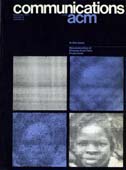December 1971 - Vol. 14 No. 12

Features
Reconstruction of pictures from their projections
Algorithmic selection of the best method for compressing map data strings
Retrieval—Update speed tradeoffs using combined indices
Implementation of the substring test by hashing
BLISS: a language for systems programming
New LISP techniques for a paging environment
A note on “A modification of Nordsieck’s method using an ‘Off-Step’ point”
Rapid computation of general interpolation formulas and mechanical quadrature rules
An extension of the Munkres algorithm for the assignment problem to rectangular matrices
Algorithm 415: Algorithm for the assignment problem (rectangular matrices)
Algorithm 416: Rapid computation of coefficients of interpolation formulas
Algorithm 417: Rapid computation of weights of interpolatory quadrature rules



